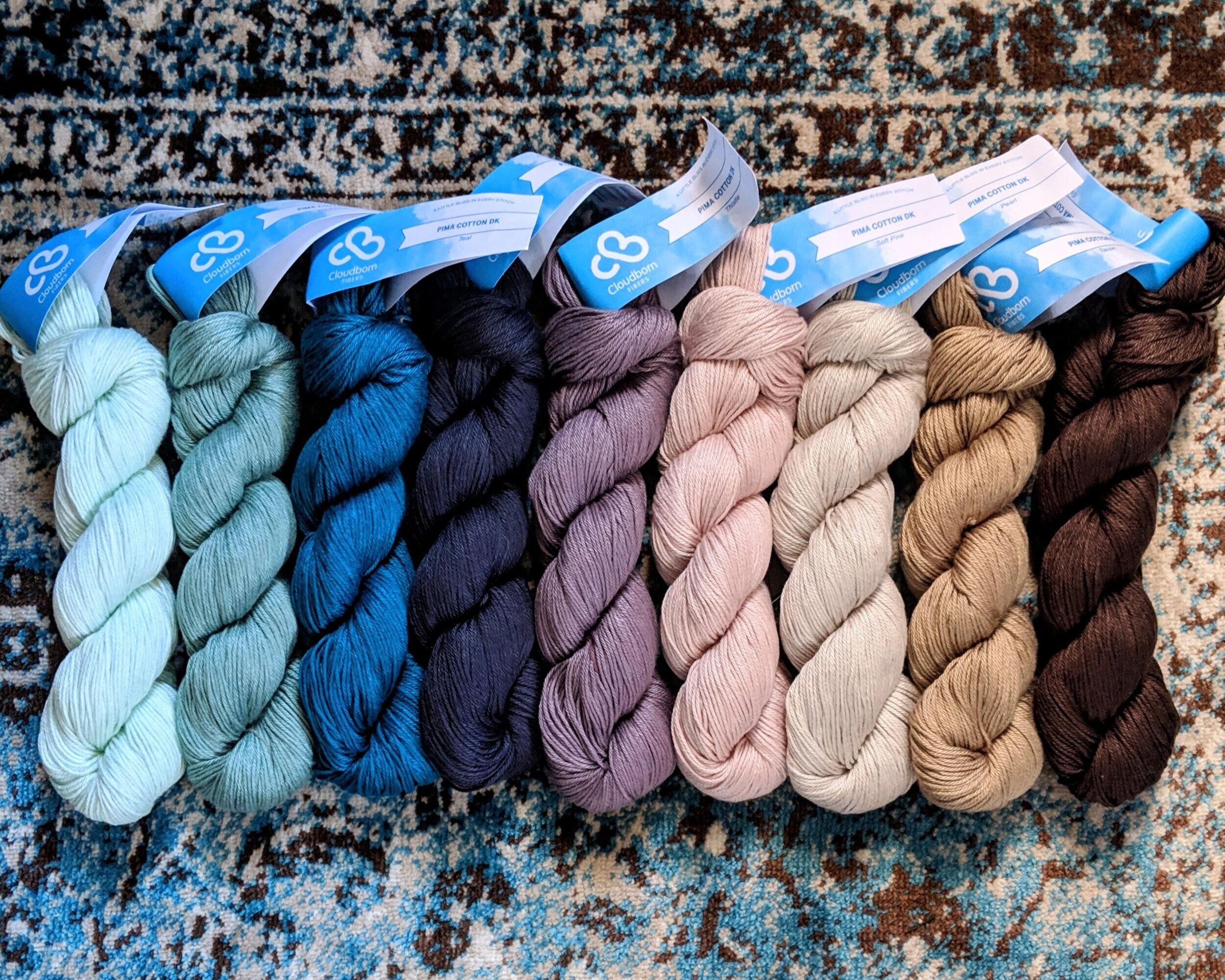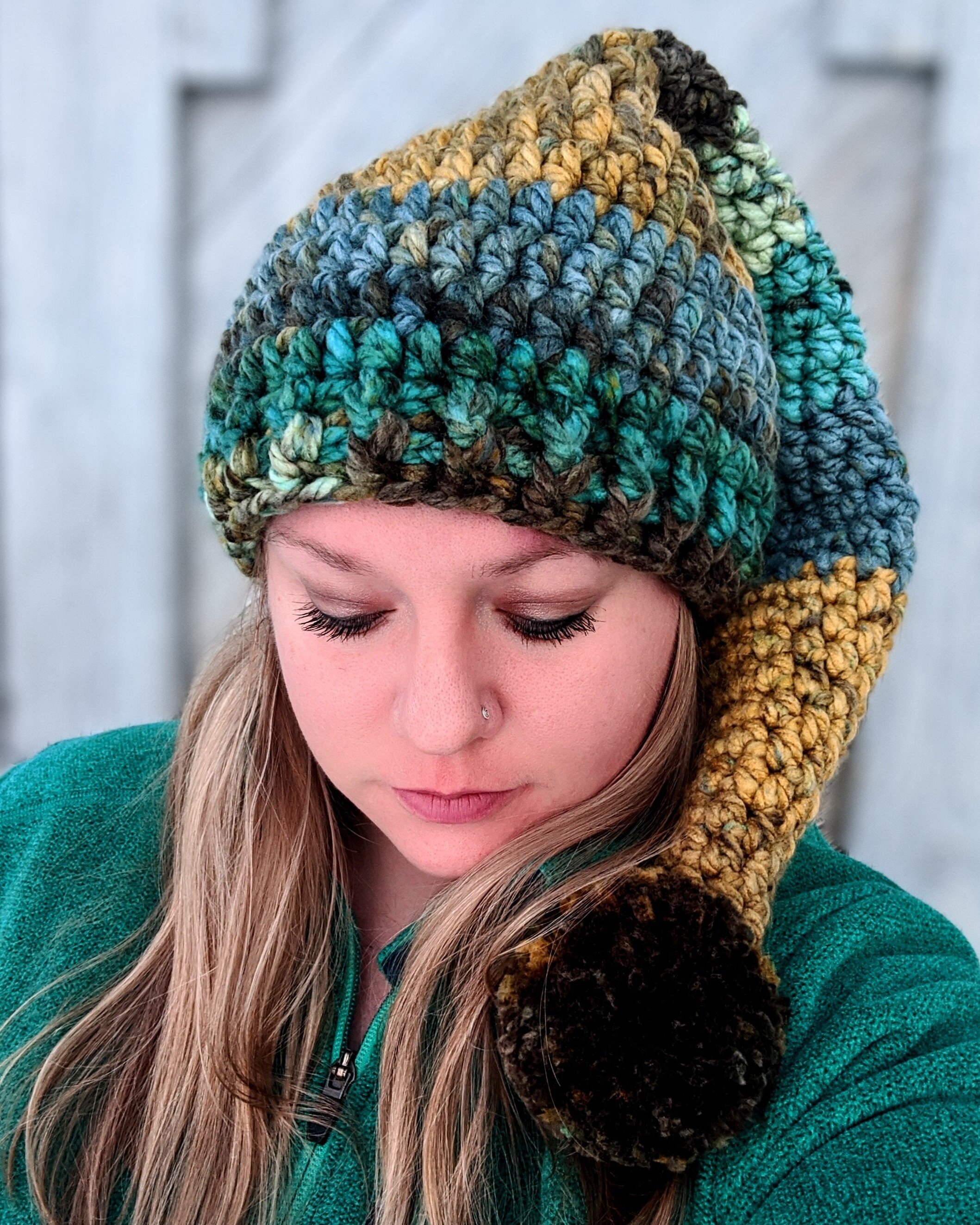Designing the Perfect Temperature Blanket
When I started my temperature blanket for 2019 I had no idea what I was getting myself into or what a huge success it would be. I’ve had so many wonderful people reach out wanting to know my secret, so I’ve decided to outline some key elements that made my blanket one of people’s favorites.
What’s a Temperature Blanket?
A temperature blanket is a crochet or knit record of the temperature throughout a set time period using predetermined temperature ranges with associated yarn colors to create a unique masterpiece. There are no specific directions or limitations for a temperature blanket, which makes it a great opportunity for crocheters and knitters to flex their creative muscles.
Curate the Vibe
Traditionally, temperature blankets are done in a rainbow color spectrum, but a rainbow just wasn’t going to match the vibe in my living room. Therefore, I went with a style that would match the aesthetic of the place I intended to use the blanket. I wanted it to be classic and classy, but still functional, and those goals were achieved by choosing the perfect colors, yarn and stitch.
Color
I know a lot of people who struggle with color. Admittedly, color has always been easy for me. I feel like it’s a talent some people have and some people don’t. Regardless, color choice is easy if you have a bit of inspiration. My inspiration: my living room rug. That’s right. A rug. Basically everything in my living room was chosen based on that rug, so I didn’t see why my temperature blanket should be any different. Therefore, I decided on cream, taupe, dark brown and teal. Yet, I didn’t quite feel like four colors were enough. That made me look deeper into the room and I picked up on my throw pillows. In the pattern I saw shades of pink, purple, and darker blues that I felt might tie the blanket together. Thus, the colors were chosen.
When choosing colors I like to have a mixture of color and neutral. I chose to pair blues, purple and pink with cream and browns. This allows for a nice balance without the project looking bland with all neutral or too busy with too much color.
Tip: All the colors are going into the same blanket, so they need to work together as a team. You know your colors will work by pairing any of your colors with another. If you have one color that looks a little funny with another it may be best to exchange it with a more compatible color. (See number 4 in the Decisions section for more information.)
Yarn
I may have went about my decision making process backwards. I chose colors before yarn, which made things a bit more challenging. Nevertheless, as an avid online yarn shopper I had a few places in mind to find exactly what I was looking for. Ultimately I chose Cloudborn Pima Cotton DK from Bluprint.I wanted a DK weight yarn made of natural fibers in perfect colors to match my space and Cloudborn fit the bill.
DK was the ideal weight because I had seen some horrific examples of temperature blankets done in larger yarns that either turned out enormous or a strange length. The smaller yarn leaves more wiggle room for a blanket that wasn’t going to be overwhelming. Natural fibers were important to me when considering the longevity of the blanket and the pima cotton also added a gorgeous sheen to my project.
Tip: If you’re a little lost when choosing a yarn, I suggest trying lovecrafts.com. It is a great place to find a wide array of wights and fibers in a variety of brands. The filter tools are very helpful to dial in on exactly what you want.
Stitches
When I was planning this blanket I wanted something new and exciting. The linen/moss/woven (whatever you want to call it) stitch has been a go-to for temperature blankets since the dawn of time and I felt like it was time for something new. However, after attempting a variety of different stitches, I decided there was a reason people chose this stitch for this project. It looks clean and has a great texture that is both squishy and stretchy.
Nevertheless, there are others who have succeeded in redesigning the traditional into something new and modern. Toni from TL Yarn Crafts took her blanket to a whole new level by choosing a Tunisian stripe pattern that is absolutely stunning.
Decisions, Decisions…
Now before we hop into the pattern, there are still some things you need to consider before you start.
What vibe are you going for?
I know we just talked about how to “curate the vibe” previously, but that was my vibe. What’s yours? Do you want something with sheen that will look great in your blue and brown living room or do you want something warm and rustic in a wool tweed? Or do you really like rainbows and want to keep it traditional? It’s all up to you!
What do you want your temperature ranges to look like?
I live in a climate where the weather is rarely the same from day to day and can range from -15 to 100°F (-26 to 38°C). That makes it easy for me to choose many temperature ranges in large degree increments. However, if you live in a climate where the temperature doesn’t fluctuate as much, you may want to choose fewer colors or shorten the degree increments. For instance, if you live in a more temperate climate your weather may range from 50 to 90°F (10 to 32°C) I would suggest 5 degree temperature ranges instead of 10, or five colors instead of nine.
Will you be recording the high, low, or average temperature for each day?
I chose to record the high temperature for each day. It seemed like the easiest option. Most people talk about the high instead of the low, and an average temperature generally won’t show as much fluctuation as the other two would. Less fluctuation means fewer fun striping patterns in your blanket.
Will you record the temperature for a specific location or your current location?
This question may seem strange, but it was something that I really had to think about. I wanted this blanket to be more about my journey through the year rather than just the temperature of the location where my house happens to be. As someone who travels a lot for work in the summers, I chose to record the temperature of the place where I stayed that night to better represent my journey through 2019. However, maybe you want a blanket that represents home and choose to make it for the town in which you currently reside. Or maybe you’re more nostalgic and want to make the blanket to represent the temperatures of your home town or a far away place you’d like to visit. There are no right or wrong answers here.
What order will you place your colors?
We discussed color and how to choose colors, but not exactly how you want them to go within the blanket. I like my colors to flow in a kind of monochromatic wave with transition colors in between. I arranged my blues from light to dark blue, then used purple and pink to transition to white, taupe and dark brown. In my neck of the woods these colors became jumbled within the blanket, having teal (30°F) next to pink (60°F) or dark blue (40°F) next to taupe (80°F) (this is why it is important for ALL colors to compliment each other), but overall, choosing a flow pattern will help the visual appeal of the finished project.
What stitch will you use?
There are a lot of options out there. I’m sharing my linen stitch pattern and Toni is probably going to write up her Tunisian pattern, but that shouldn’t be your limiting factor. There are tons of online tutorials and stitch dictionaries that teach beautiful stitches. If you aren’t feeling wowed the provided options, forge your own path! Just make sure that you try a swatch and do your math before you dive in. Try to stick with stitches that aren’t too tall and avoid creating one of those strangely long temperature blankets that make me feel uncomfortable when I look at it.
How will you keep track of the temperatures?
I’ll tell you how! Click HERE for the 2020 temperature blanket record pages! Or just simply use a sheet of notebook paper. Regardless, staying up to date on tracking the temperatures will help you stay focused on the project. But never fear, if you happen to miss a day of tracking timeanddate.com has a feature that allows you to look at past dates and shows you both the high and the low temperature.
My Decisions
Here are my decisions for my 2019 and 2020 blankets:
What vibe are you going for?
2019 - Classy and classic in pima cotton to match my living room decor.
2020 - Rustic and cozy in wool blend tweed to carry with me when I travel.
What do you want your temperature ranges to look like?
2019 - (in degrees F) <19, 20-29, 30-39, 40-49, 50-59, 60-69, 70-79, 80-89, >90
2020 - The same 9 ranges
Will you be recording the high, low, or average temperature for each day?
2019 - High
2020 - High
Will you record the temperature for a specific location or your current location?
2019 - Current location
2020 - Home town
What order will you place your colors in?
2019 - (Cloudborn Pima Cotton DK) Mint, Caribbean, Teal, Slate, Thistle, Soft Pink, Pearl, Taupe, Espresso
2020 - (Knit Picks City Tweed DK) Orca, Porpoise, Jacquard, Kale, Artichoke, Snowshoe, Plum Wine, Brocade, Obsidian
What stitch will you use?
2019 - Linen
2020 - Hexagon Granny
The Pattern
Materials
4,620yds (4,220m) DK weight yarn
about 20 skeins of Cloudborn Pima Cotton DK
Size US G+ (4.5mm) crochet hook
Tapestry needle
Scissors
Finished Size
75x50” (190.5x127cm)
Gauge
21 sts + 22 rows = 4”/10cm in linen st
Abbreviations
*All WYldflower Crochet patterns are written in US terms*
Ch - chain
Sc - single crochet
Sk - skip
Sl st- slip stitch
Sp - space
St(s) - stitch(s)
Notes
1 row represents 1 day.
Foundation ch should be the same color as the first row.
Change colors as needed to maintain the weather-determined pattern.
2020 is a leap year, so there will be 366 rows instead of 365.
Future leap years: 2024, 2028, 2032, 2036, 2040…
Pattern
Ch 303
Row 1: Sc in 3rd ch from hook. *Ch 1, sk 1 ch, sc in next ch* to end of row. Turn.
Row 2-365 (leap year 366): Ch 2. Sk first sc, *sc in ch 1 sp, ch 1* to ch 2 sp, sc in ch 2 sp. Turn.
Row 366 (leap year 367): sl st into each sc and ch sp across. Tie off and weave in ends.
It’s as simple as that!
Don’t forget to tag #wyldflowercrochet when posting updates on Instagram.
I can’t wait to see and share your work!
























